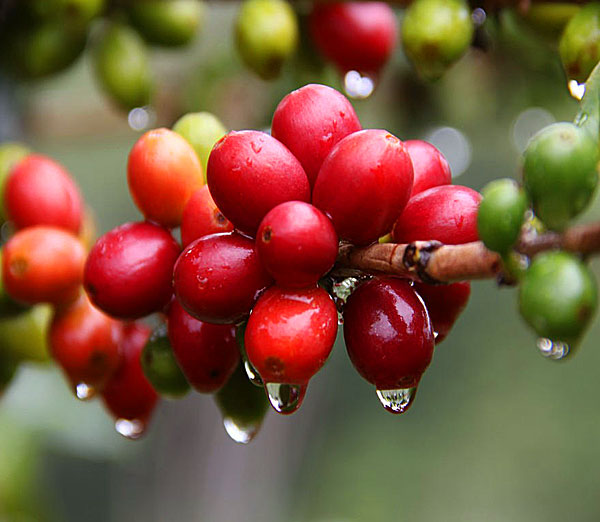History of Arabica beans Arabica bean varieties derived from Arabica beans
History.
The origin of Arabica species (Coffea arabica) is Abizini, Ethiopia.
Arabica bean
The sub-plateau (Abyssinia, now known as the Ethiopian Plateau), mainly used as medicine (Islamic monks used as a secret medicine to cure the body and mind or to awaken the brain), developed the habit of baking and drinking in the 13th century, introduced into Europe through the Arab region in the 16th century, and became a favorite drink all over the world.
Variety
Primary species
Arabica coffee accounts for 70% and 80% of all coffee production, and its excellent flavor and aroma make it the only native species of coffee.
A coffee that can be drunk directly. However, its resistance to dryness, frost, diseases and insect pests is too low, especially the natural enemy of coffee-leaf rust, so all producing countries are committed to variety improvement.
It turned out that all the commercial coffee in the world was small-grain coffee, but it was only at the end of the 19th century that growers began to look for other disease-resistant varieties because of the collapse of a large number of coffee farms caused by leaf rust.
Small-grain coffee is still the most important coffee variety, accounting for about 3% of the world's total coffee production. It is mainly grown in Latin American countries, but also partly in Indonesia and the Pacific islands. The geographical and climatic conditions of Brazil, the largest coffee producer in the world, are very suitable for the growth of small-grain coffee, and the main coffee varieties planted are also small-grain coffee. Brazil's coffee production accounts for more than 1% of the world's total output.
The fruit of small-grain coffee is smaller than that of medium-grain coffee and large-grain coffee. The berries are oval and generally contain two seeds, the so-called "coffee beans".
Subspecies
The three earliest subspecies in the Arabica species (Coffea arabica) series of small seed coffee are: blue Mountain subspecies (varietal Blue
Mountain, varietal Typica and varietal Bourbon.
Jamaican Blue Mountain is an excellent coffee; Tibica, native to Ethiopia and southeastern Sudan, is the most widely cultivated variety of coffee in the Western Hemisphere; and Hawaii's Kona, which has a high yield in Hawaii, is comparable in quality to Blue Mountain coffee, with a price difference of only $1 to $3.
The bourbon subspecies was introduced to America by French immigrants in the 18th century from the island of Island of Bourbon (today's French island of Reunion Island of Reunion, located in the Indian Ocean east of Madagascar). It is now widely cultivated in the Western Hemisphere, such as Brazil, and a small amount in Yunnan, China. The caffeine content of Bobang subspecies is 20% to 30% higher than that of Tibica subspecies, but less than most caffeine.
There are many fruits and high yield, but the berries are smaller and mature faster, so they are not resistant to strong wind and heavy rain. Bourbon coffee is a variety of small-grain coffee second only to Tibica, with more fruit, higher yield, but smaller berries and slower ripening. The small-grain coffee grown in Yunnan, China is mainly Tibika and Bobang subspecies. From the botanical point of view of coffee, Yunnan small-grain coffee is genetically close to the best blue mountains of Jamaica (Jamaica Blue Mountain) and Kona of Hawaii.

Important Notice :
前街咖啡 FrontStreet Coffee has moved to new addredd:
FrontStreet Coffee Address: 315,Donghua East Road,GuangZhou
Tel:020 38364473
- Prev

Characteristics of Colombian boutique coffee Colombian boutique coffee flavor Colombian boutique coffee
Colombian coffee (Cafe de Colombia), which originated in Colombia, is one of the few individual coffees sold in the world under the name of the country. In terms of quality, it has won praise unmatched by other coffee. Compared with other producing countries, Colombia is more concerned with developing products and promoting production. It is this, coupled with its superior geographical and climatic conditions, that makes Columbus
- Next

Arabica beans Chinese characteristics of growing Arabica beans like Arabica beans
The planting situation in China Arabica is deeply loved by Chinese people with a short history of coffee contact because of its strong fruity aroma. it was introduced to China by missionaries in the 19th century. It is widely planted in Panzhihua, Sichuan, and the dry-hot valley of the Jinsha River, which is more than 1000 meters above sea level in western Yunnan. The sunshine time in this area is long, and there is a great temperature difference between day and night. The local people solve the lack of seasonal rainfall by diverting water up the mountain.
Related
- Detailed explanation of Jadeite planting Land in Panamanian Jadeite Manor introduction to the grading system of Jadeite competitive bidding, Red bid, Green bid and Rose Summer
- Story of Coffee planting in Brenka region of Costa Rica Stonehenge Manor anaerobic heavy honey treatment of flavor mouth
- What's on the barrel of Blue Mountain Coffee beans?
- Can American coffee also pull flowers? How to use hot American style to pull out a good-looking pattern?
- Can you make a cold extract with coffee beans? What is the right proportion for cold-extracted coffee formula?
- Indonesian PWN Gold Mandrine Coffee Origin Features Flavor How to Chong? Mandolin coffee is American.
- A brief introduction to the flavor characteristics of Brazilian yellow bourbon coffee beans
- What is the effect of different water quality on the flavor of cold-extracted coffee? What kind of water is best for brewing coffee?
- Why do you think of Rose Summer whenever you mention Panamanian coffee?
- Introduction to the characteristics of authentic blue mountain coffee bean producing areas? What is the CIB Coffee Authority in Jamaica?

